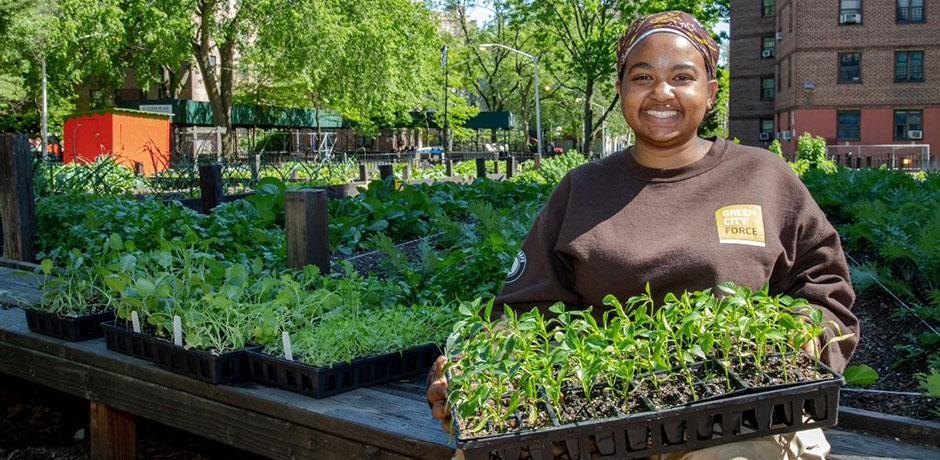City Blooming Fundamentals Explained
City Blooming Fundamentals Explained
Blog Article
Getting My City Blooming To Work
Table of ContentsRumored Buzz on City BloomingThe Ultimate Guide To City BloomingExcitement About City BloomingThings about City BloomingSome Ideas on City Blooming You Need To Know
Fascinated in growing food for sale in the City of Chicago? Below is a listing of regularly asked questions concerning the policies and laws that cultivators need to think about when planning a city agriculture task.
The zoning amendment does not change any various other codes managing composting, structure licenses, purchasing or leasing City owned home, company licenses or environmental contamination. There are existing codes that control these concerns and they remain completely effect and may be relevant to your project. Neighborhood gardens are generally owned or handled by public entities, civic companies or community-based companies and kept by volunteers.
Urban farms expand food that is meant to be offered, either on a nonprofit or for-profit basis. Because of their business function, urban farms call for a service permit. Yes. A neighborhood garden is allowed to sell excess generate that was grown on website if the sales are accessory or subordinate to the garden's key purpose defined over.
The Buzz on City Blooming
Composting is enabled yet just for plant product that is generated and utilized on website. The amount of garden compost product can not go beyond 25 cubic backyards at any given time according to the standards in 7-28-715 of the City's Municipal Code. Yes. Because the dirt at the majority of brand-new yard sites requires amending, compost, dirt, wood chips, or various other products can be gotten to build or enhance the expanding room - City gardening.

If a structure authorization is needed after that the hoophouse will certainly be thought about an accessory building. You can figure out more about the building license needs by speaking to the Division of Structures. The 25,000-square-foot dimension restriction is meant to stop a solitary area garden from dominating an offered block or diminishing the block's existing household or business character.
The restriction does not use to gardens situated in Public Open Space (POS) areas. Can there be even more than one neighborhood yard that is 25,000 square feet on a solitary block? Fence is not required, however, yards that have large car parking locations might be needed to mount fencing or various other landscape design attributes.
The Buzz on City Blooming
B1 & B2 districts need that all industrial use tasks be carried out inside your home. R areas limit commercial activity. The guidelines show the purpose and intent of the Zoning Code. Is fence needed for metropolitan ranches? Yes. Fencings might be required, along with landscape design and screening, for sure parking lot and outside job or storage space locations depending upon area and the certain activity taking location.
Yes. Urban farms call for building permits and zoning approvals prior to construction. Various other forms of city review might be required depending on particular frameworks, tasks, size, landscape design, licensing, public health and stormwater monitoring problems. Most of these needs are recognized in the task design or permitting process, nevertheless, the candidate might be accountable to individually recognize particular licenses or allows that might be required.
The Department of Service Affairs and Customer Protection can assist figure out the particular kind of company permit that's needed. Off road vehicle parking is required for the majority of commercial projects in Chicago. The needed number of auto parking rooms is based on the number of workers working on site and not the square footage of the growing area.
City Blooming Fundamentals Explained

An urban ranch can market compost product created on site, however, the procedure should conform with the guidelines in 7-28-715 of the Chicago Municipal Code. Aquaponic systems are allowed inside your home on urban farms in lots of zoning areas.
Approximately five hives or colonies of honey bees might be maintained as an accessory use. Beekeepers should register with the Illinois Division of Agriculture. To find out more regarding the proposed zoning change you may contact the Division of Housing and Economic Growth, Bureau of Preparation and Zoning at 312.744.8563.
Farming in cities and urban areas A city ranch in Chicago. Urban agriculture refers to different practices of cultivating. https://www.evernote.com/shard/s416/sh/76427f1e-db42-71c3-1e07-e8ebfa2fefe5/AF51jmfHpNcDRC9u_dl3krlbzdyP7xITRgVg4ufD6qAMWS5gU0WOhxsSWA, handling, and dispersing food in urban locations. The term additionally applies to the location activities of animal husbandry, aquaculture, beekeeping, and gardening in a city context. Urban agriculture is identified from peri-urban agriculture, which occurs in country areas beside suburbs.
A Biased View of City Blooming
, who seek to develop social networks started on a shared ethos of nature and neighborhood holism. These networks can develop by means of formal institutional support, ending up being integrated right into regional community planning as a "transition town" activity for lasting urban advancement.
In either situation, the much more direct accessibility to fresh vegetable, fruit, and meat items that may be know with metropolitan agriculture can boost food security and anchor food security while decreasing food miles, bring about reduced greenhouse gas emissions, thereby contributing to environment change reduction. A few of the initial proof of metropolitan agriculture comes from Mesopotamia.
Report this page